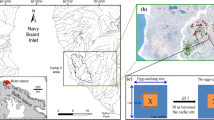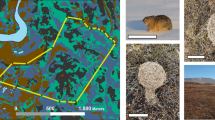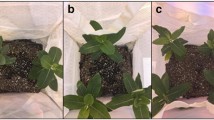Abstract
This study links summer foraging and scatter-hoarding to winter larder-hoarding and winter survival in yellow pine chipmunks (Tamias amoenus) by comparing patterns of time allocation and winter larder contents in 2 years with very different levels of resource availability. In 2003, seed production and the number of trees and shrubs producing seeds were high. In 2004 seed crops were small. Chipmunks allocated more time to foraging when food resources were scarce (66% in 2004) compared to when they were abundant (39% in 2003). Increased time allocated to foraging in 2004 corresponded to significant decreases in time allocated to vigilance, resting, and social interactions. When seeds were scarce (i.e., in autumn 2004), chipmunks spent more time searching for cached food items than gathering seeds from plants or the ground surface. Despite the increase in foraging effort, the edible mass and caloric contents of larders were significantly smaller in 2004. In the year with low seed production, the diversity of seed species found in larders increased, and many of these seeds were of species that ripened in summer. When autumnal seed production by Jeffrey pine seeds was high, Jeffrey pine seeds were nearly the exclusive food item found in larders. Larder contents would have provisioned chipmunks for an estimated 116–257 days in 2003 and but only 6–111 days in 2004. It is likely that all chipmunks would have survived the winter of 2003 (duration ~110–120 days). However, none of the larders recovered in 2004 contained enough food to have provisioned the inhabitant for the ~148–158 days of winter.



Similar content being viewed by others
References
Aebischer NJP, Robertson A, Kenward RE (1993) Compositional analysis of habitat use from animal radio-tracking data. Ecology 74:1313–1325
Aunfriev AI, Arkhipov GG (2004) Influence of body weight and size on the mode of wintering in hibernators of the family Sciuridae in northeastern Russia. Russ J Ecol 35:189–193
Barnes BM (1984) Influence of energy stores on activation of reproductive function in male golden-mantled ground squirrels. Comp Physiol B Biochem Syst Environ Physiol 154:421–425
Barnes BM (1986) Annual cycle of gonadotropins and androgens in hibernating golden-mantled ground squirrels. Gen Comp Endocrinol 62:13–22
Baynes JM, Dominiczak MH (1999) Medical biochemistry. Elsevier, London
Boggs CL (1992) Resource allocation: exploring connections between foraging and life history. Funct Ecol 6:508–518
Boutin S, Wauters LA, McAdams AG, Humphries MM, Tosi G, Dhondt AA (2006) Anticipatory reproduction and population growth in seed predators. Science 314:1928–1930
Broadbooks HE (1958) Life history and ecology of the chipmunk, Eutamias amoenus, in eastern Washington. Misc Publ Mus Zool Univ Mich 103
Brown JS, Kotler BP, Smith RJ, Wirtz WO II (1988) The effects of owl predation on the foraging behavior of heteromyid rodents. Oecologia 76:408–415
Congdon JD, Dunham AE, Tinkle DW (1982) Energy budgets and life histories of reptiles. Biology of reptiles. In: Gans C, Poughs FH (eds) Biology of the reptilia, vol 13. Academic Press, New York, pp 233–271
Curran LM, Leighton M (2000) Vertebrate responses to spatiotemporal variation in seed production of mast-fruiting Dipterocarpaceae. Ecol Monogr 70:101–128
Dark J (2005) Annual lipid cycle in hibernators: integration of physiology and behavior. Annu Rev Nutr 25:469–497
Dunford C (1972) Summer activity of eastern chipmunks. J Mammal 53:176–180
Dunham AE, Overall KL (1994) Population responses to environmental change: life history variation, individually-based models, and the population dynamics of short-lived organisms. Am Zool 34:382–396
Dunham AE, Grant BW, Overall KL (1989) Interface between biophysical and physiological ecology and the population ecology of terrestrial vertebrate ectotherms. Physiol Zool 62:335–355
Elliott L (1978) Social behavior and foraging ecology of the eastern chipmunk (Tamias striatus) in the Adirondack Mountains. Smithsonian Contrib Zool 265:1-107
French AR (1992) Mammalian dormancy. In: Tomasi TE, Horton TH (eds) Mammalian energetics. Comstock, Ithaca, pp 105–121
French AR (2000) Interdependency of stored food and changes in body temperature during hibernation of the eastern chipmunk, Tamias striatus. J Mammal 81:979–985
Geiser F, Hiebert S, Kenagy GJ (1990) Torpor bout duration during the hibernation season of two sciurid rodents: interrelationship with temperature and metabolism. Physiol Zool 63:489–503
Gendron RP, Reichman OJ (1995) Food perishability and inventory management: a comparison of three caching strategies. Am Nat 145:948–968
Gunnarsson TG, Gill JA, Newton J, Potts PM, Sutherland WJ (2005) Seasonal matching of habitat quality and fitness in a migratory bird. Proc R Soc B Biol Sci 272:2319–2323
Gworek JR, Vander Wall SB, Brussard PF (2007) Changes in biotic interactions and climate determine recruitment of Jeffrey pine along an elevational gradient. For Ecol Manage 239:57–68
Hobson KA (2005) Stable isotope and the determination of avian migratory connectivity and season interactions. Auk 122:1037–1048
Humphries MM, Thomas DW, Kramer DL (2001) Torpor and digestion in food-storing hibernators. Physiol Biochem Zool 74:283–292
Humphries MM, Thomas DW, Kramer DL (2003a) The role of energy availability in mammalian hibernation: a cost-benefit approach. Physiol Biochem Zool 76:165–179
Humphries MM, Kramer DL, Thomas DW (2003b) The role of energy availability in mammalian hibernation: an experimental test in free-ranging eastern chipmunks. Physiol Biochem Zool 76:180–186
Hutchins HE, Lanner RM (1982) The central role of Clark’s nutcracker in the dispersal and establishment of whitebark pine. Oecologia 55:192–201
Kawamichi M (1989) Nest structure dynamics and seasonal use of nests by Siberian chipmunks (Eutamias sibiricus). J Mammal 70:44–57
Kawamichi M (1996) Ecological factors affecting annual variation in commencement of hibernation in wild chipmunks (Tamias sibiricus). J Mammal 77:731–744
Ligon JD (1974) Green cones of the piñon pine stimulate late summer breeding in the piñon jay. Nature 250:80–82
Lima SL, Dill LM (1990) Behavioral decisions made under the risk of predation: a review and prospectus. Can J Zool 68:619–640
McNamara JM, Houston AI (1986) Common currency for behavioral decisions. Am Nat 127:358–378
Michener GR (1984) Age, sex and species differences in the annual cycle of ground-dwelling sciurids: implications of sociality. In: Murie JO, Michener GR (eds) The biology of ground-dwelling squirrels. University of Nebraska Press, Lincoln, pp 81–107
Munro D, Thomas DW, Humphries MM (2005) Torpor patterns of hibernating eastern chipmunks (Tamias striatus) vary in response to the size and fatty acid composition of food hoards. J Anim Ecol 74:692–700
Myers JP (1981) Cross-seasonal interactions in the evolution of sandpiper social systems. Behav Ecol Sociobiol 8:195–202
Neuhaus P, Bennett R, Hubbs A (1999) Effects of a late snowstorm and rain on survival and reproductive success in Columbian ground squirrels (Spermophilus columbianus). Can J Zool 77:879–884
Norberg R (1977) An ecological theory on foraging time and energetics and choice of optimal food-searching method. J Anim Ecol 46:511–529
Norris DR, Taylor CM (2006) Predicting the consequences of carry-over effects for migratory populations. Biol Lett 2:148–151
Olsen CL (1974) Comparative robustness of six tests in multivariate analysis of variance. J Am Stat Assoc 69:894–908
Panuska JA (1959) Weight patterns and hibernation in Tamias striatus. J Mammal 40:554–566
Place NJ, Veloso C, Visser GH, Kenagy GJ (2002) Energy expenditure and testosterone in free-living male yellow-pine chipmunks. J Exp Zool 292:460–467
Pollock KH, Nichols JD, Browie C, Hines JE (1990) Statistical inference for capture-release experiments. Wildl Monogr 107:3–97
Real L, Caraco T (1986) Risk and foraging in stochastic environments. Annu Rev Ecol Syst 17:371–390
Ricklefs RE, Wikelski M (2002) The physiology/life-history plexus. Trends Ecol Evol 17:462–468
Sokal RR, Rolf FJ (1994) Biometry, 3rd edn. Freeman, San Francisco
Steffen JM, Koebal DA, Musacchia XJ, Milsom WK (1991) Morphometric and metabolic indices of disuse in muscles of hibernating ground squirrels. Comp Biochem Physiol 99B:815–819
Tomback DF (1978) Foraging strategies of Clark’s nutcracker. Living Bird 16:123–161
Tomback DF (1982) Dispersal of whitebark pine seeds by Clark's nutcracker: a mutualism hypothesis. J Anim Ecol 51:451-467
Vander Wall SB (1995) Sequential patterns of scatter hoarding by yellow pine chipmunks (Tamias amoenus). Am Midl Nat 133:312–321
Vander Wall SB, Jenkins SH (2003) Reciprocal pilferage and the evolution of food-hoarding behavior. Behav Ecol 14:656–667
White GC, Burnham KP (1999) Program MARK: survival estimation from populations of marked animals. Bird Study 46 (Suppl):120–138
Williams BK, Nichols JD (1984) Optimal timing in biological processes. Am Nat 123:1–19
Williams BK, Nichols JD, Conroy MJ (2002) Analysis and management of animal populations. Academic Press, San Diego
Wingfield JC, Maney DL, Breuner CW, Jacobs JD, Lynn S, Ramenofsky M, Richardson RD (1998) Ecological bases of hormone-behavior interactions: the emergency life history stage. Am Zool 38:191–206
Acknowledgements
We would like to thank S. Agosta, M. Beck, L. Colgin, S. Hampton, M. Lind, and C. Mattson for their help in the field. We are especially grateful to J. Gworek for use of her rodent trapping data, J. Hayes for the use of his telemetry equipment, P. Lemons for helping with analysis of trapping data, and C. Nowak who assisted in seed identification. We would like to thank S. Agosta, S. Jenkins, W. Longland, M. Humphries, and three anonymous reviewers for providing useful comments on earlier drafts of this manuscript. This research was conducted in concordance with Animal Care and Use Protocols.
Author information
Authors and Affiliations
Corresponding author
Additional information
Communicated by Jacek Radwan.
Rights and permissions
About this article
Cite this article
Kuhn, K.M., Vander Wall, S.B. Linking summer foraging to winter survival in yellow pine chipmunks (Tamias amoenus). Oecologia 157, 349–360 (2008). https://doi.org/10.1007/s00442-008-1072-4
Received:
Accepted:
Published:
Issue Date:
DOI: https://doi.org/10.1007/s00442-008-1072-4




